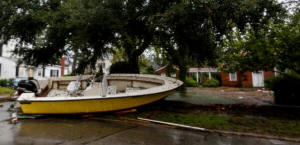|
Florence lumbers inland, leaving five
dead, communities flooded
 Send a link to a friend
Send a link to a friend
 [September 15, 2018]
By Ernest Scheyder [September 15, 2018]
By Ernest Scheyder
WILMINGTON, N.C. (Reuters) - Tropical storm
Florence lumbered inland on Saturday, knocking down trees, flooding
rivers, and dumping sheets of rain in the Carolinas where five people
have died.
It diminished from hurricane force as it came ashore, but forecasters
said the 350-mile-wide storm's slow progress across North and South
Carolina could leave much of the region under water in the coming days.
"This storm is relentless and excruciating," North Carolina Governor Roy
Cooper told CNN late on Friday. "There is probably not a county or a
person that will not be affected in some way by this very massive and
violent storm."
A mother and baby were killed when a tree fell on their home in
Wilmington, North Carolina. The child's injured father was taken to
hospital. In Pender County, a woman died of a heart attack; paramedics
trying to reach her were blocked by debris.
Two people died in Lenoir County. A 78-year-old man was electrocuted
attempting to connect extension cords while another man died when he was
blown down by high winds while checking on his hunting dogs, a county
spokesman said.

In New Bern, North Carolina, the storm surge overwhelmed the town of
30,000 which is located at the confluence of the Neuse and Trent rivers.
Officials in New Bern, which dates to the early 18th century, said more
than 100 people were rescued from floods and the downtown was under
water by Friday afternoon.
Resident Jay Manning said he and his wife watched with alarm as water
filled the street.
“We moved all the furniture up in case the water comes in but the water
seems to be staying at the edge of the driveway,” he said, adding that
if the wind picks up and the rain keeps coming, that could change. “My
wife’s in a panic right now.”
Dan Eudy said he and his brother were awakened on Thursday night by the
sound of a boat ramming against his front porch.
Eudy said his family stayed in their home partly to protect their house.
"And we had no belief it would be as significant an event as it was,” he
said. “This is a 500- or 1,000-year event.”
HEAVY RAIN
Florence was a Category 3 hurricane on the five-step Saffir-Simpson
scale with 120-mph winds on Thursday. It was downgraded to a Category 1
hurricane before coming ashore near Wrightsville Beach close to
Wilmington, North Carolina.
The National Hurricane Center (NHC) downgraded it to a tropical storm on
Friday, but warned it would dump as much as 30 to 40 inches (76-102 cm)
of rain on the southeastern coast of North Carolina and part of
northeastern South Carolina.
[to top of second column]
|

Boats pushed away from the dock are seen on a street during the
passing of Hurricane Florence in the town of New Bern, North
Carolina, U.S., September 14, 2018. REUTERS/Eduardo Munoz

About 10 million people could be affected by the storm.
More than 22,600 people were housed in 150 shelters statewide,
including schools, churches and Wake Forest University’s basketball
arena.
"This rainfall will produce catastrophic flash flooding and
prolonged, significant river flooding," the hurricane center said.
Atlantic Beach on North Carolina's Outer Banks islands had already
received 30 inches of rain, the U.S. Geological Survey said, while
more than 25 inches have fallen in the Newport, Morehead City area
since Thursday.
North Carolina utilities estimated that as many as 2.5 million state
residents could be left without power, the state's Department of
Public Safety said.
The White House said on Friday that President Donald Trump had
spoken with state and local officials, assuring them the federal
government was prepared to help. Trump plans a visit to the region
next week.
Florence was moving west-southwest at about 5 mph (7 km/h), with its
center located over eastern South Carolina. The storm is expected to
turn west and then north moving through the Carolinas and the Ohio
Valley by Monday, the NHC said early on Saturday.
The storm was expected to become a tropical depression on Saturday
and significant weakening was expected over the weekend, the NHC
said in a bulletin.
Florence was one of two major storms threatening millions of people
on opposite sides of the world.
Super Typhoon Mangkhut tore through the northern tip of the
Philippines on Saturday packing winds of more than 200 km per hour
(124 mph) along with torrential rain, killing three people and
causing floods, landslides and power outages. [nL3N1W05TE]
(Additional reporting by Gene Cherry in Raleigh; Scott DiSavino and
Gina Cherelus in New York; Makini Brice in Washington; Andy Sullivan
in Columbia, South Carolina; and Brendan O'Brien in Milwaukee;
writing by Bill Trott and Dan Whitcomb; editing by Bill Tarrant and
Jason Neely)
[© 2018 Thomson Reuters. All rights
reserved.]
Copyright 2018 Reuters. All rights reserved. This material may not be published,
broadcast, rewritten or redistributed.
Thompson Reuters is solely responsible for this content.
 |